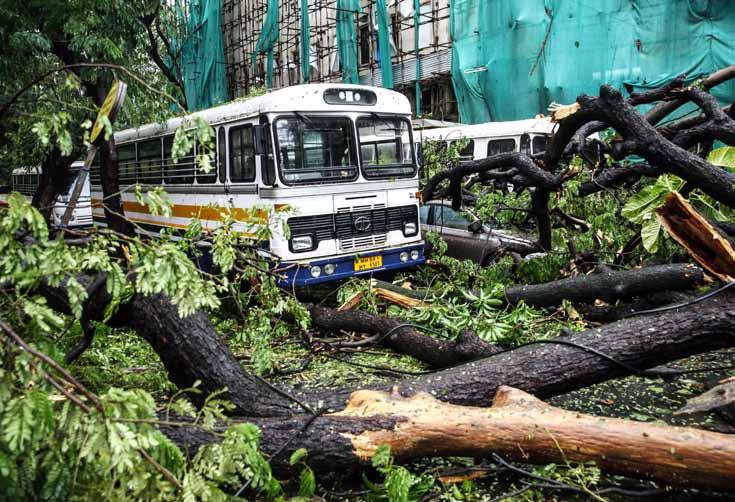
12 minute read
Iluka 4.1 with Oaklands Facade
from 2020-08 Melbourne
by Indian Link
Starting from $289,000*
*Sydney based pricing
A modern Sydney home is epitomised by an inviting open plan living and dining area that flows into an alfresco space.
The Iluka 4.1 is one of our popular designs, the floor plan boasts a large kitchen close to the dining area, 4 bedrooms making this the perfect home for a big or growing family, with each room enjoying built-in wardrobes The master bedroom offers a walk-in wardrobe and an ensuite bathroom. To bring the family together and there is a home theatre just off the living room, but separate from the open living spaces.
If you also build a single storey home with New Living Homes you can pick $35,000* worth of upgrades that you want for free!



AI Express plane landed deep in touchdown zone, inclement weather blamed
Heavy rains, along with low visibility, are being cited by aviation industry experts as the key reasons that caused the horrific plane tragedy at Kerala's Kozhikode airport on 7 Aug.
An Air India Express flight, returning from Dubai under the 'Vande Bharat' mission with 190 people on board, skidded off the runaway at the 'table top' airport in Kozhikode, and plunged 35 feet into the valley below, leaving 18 persons dead, including both the pilots.
According to a senior Airports Authority of India official, factors related to the inclement weather seem to have led the aircraft to land some 1,000 metres ahead of the safety margin - the required runway length mandated for aircraft to land at airports like the one in Kozhikode.
The total length of this runway is 2,700 metres (nearly 10,000 feet).
The aircraft cleared the required ground-roll area and landed deep into the touchdown zone.
"It was raining over the airfield and reported visibility at the time of landing was 2,000 metres and wind direction and speed was 270/08 (wind was gusting from 8 to 17 knots)," the AAI said in a statement.
It said that runway 28 was in use and the pilot attempted the first landing on it "but after a missed approach, he requested for runway 10".
The AAI also pointed out that both the runways at Kozhikode are equipped with the Instrument Landing System (ILS).
"The airport's safety services were pressed into action as per airport emergency plan for timely action," the statement said.
Senior aviators however, pointed out that the aircraft could have been diverted, as the airport in question is said to have rubber deposits on the runway, making it more prone to skid accidents. "It seems that multiple factors were at play here," said one of them.
"Without central lighting equipment, it is a 'Dark-Hole' approach to land at the airport,"an industry insider told IANS.
Other aviators have cited the need for an expanded runway area.
In all, the aviation experts agree that a number of factors contributed in playing out of this tragedy.
The Centre has said that a formal enquiry will be conducted into the incident.
Grander Ram temple in Ayodhya as per Vastu Shastra
The Ram temple that is being built at the Ram Janmabhoomi site in Ayodhya in Uttar Pradesh will be on a grander scale compared with one proposed earlier -- it will now have five domes and one tower, increasing the temple height by 20 feet to 161 feet.
The temple will be built in Nagara style, following the principles of Vastu Shastra.
The temple design finalised in the ‘90s had visualised a double-storeyed structure with three mandaps or domes and one shikhar or tower.
According to architect Ashish Sompura, son of the project's chief architect Chandrakantbhai Sompura, the original design had three mandaps - the garbhgriha or the sanctum, and kudu mandap and nritya mandap. But the new design has a rang mandap which will be towards the temple front, a kirtan mandap and prarthana mandaps on both sides as well.
Ashish said that since the height of the temple height and floors has been increased, the temple has to be extended on the sides to balance out the design aesthetically.
The columns, which in the original design were 212, have now been increased to 360.
"In the older times, nritya and rang mandaps were used for dance by devdasis (temple dancers). But now the space will be for darshan of Lord Ram from three sides," he explained.
Chief architect Chandrakant Bhai Sompura, whose grandfather Prabhakarji Sompura had designed the Somnath temple, said that the temple design is based on Vastu Shastra.
The 77-year-old said, "My grandfather had written several books on Vastu and for generations we have been using the art in our designs."
"The Nagara style Ram Mandir is designed keeping the specifications of Shilpa Shastra in mind. All calculations are very particular. For instance, no dimension can be bigger than the sanctum and the direction of the same has to be as per Vastu specifications," said Ashish.
According to the architects, the temple construction will take three-and-a-half years.
Almost 50 per cent of the work, based on the original design - 106 columns, walls of the sanctum and marble chaukathis complete. But since the design is now for a bigger temple, more stone carvings will have to be done.
Besides, four smaller temples will be built around the main structure.
The temple trust plans to meet the construction cost through crowdfunding.
Indian American appointed New York City health commissioner
Indian American doctor Dave Chokshi has been appointed New York City’s health commissioner to lead the next phase of city’s fight against the Covid-19 pandemic.
When appointing him, Mayor Bill de Blasio called him a “leader and a visionary” who was “ready to fight this fight” against the pandemic.
Chokshi is a former White House Fellow when Barak Obama was the president under the programme that brings promising young graduates to work in the president’s office. He was a Rhodes scholar at Oxford University, received his medical degree from the University of Pennsylvania, and trained at Harvard Medical School.
The new health commission is the former chief population health officer at the city’s Health + Hospitals Corporation, said to be the largest health network in the US.
Former Surgeon General Vivek Murthy praised Chokshi’s appointment.
“For the last 15 years, I have seen Dr Chokshi touch the lives of patients and communities in profound ways as a physician and public health leader,” he said. “He is of a rare breed of leaders who combine brilliance and strong judgement with humility and compassion.”
Chokshi, who grew up in Louisiana State, recalled his father’s decades-long struggle with diabetes, which made him realise that heath was linked to opportunity.
“Opportunity is what propelled my grandfathers to move from small villages in Gujarat, India, to Mumbai, the New York City of India two generations ago. My father was the first in his family to immigrate to the United States,” he said.
Although he will be the top health official for the city of about 8.5 million people, Chokshi insisted he would continue to see patients at his practice which sees many immigrant patients.
Meanwhile, New York City girds itself against the risk of a second flare up and the oncoming flu season.
Once the epicentre of the pandemic, New York City saw more than 200,000 cases and 23,000 deaths. As it heals, it is now seeing under 100 daily cases this month. But more businesses and offices, and schools, are set to start soon, requiring special health measures under close monitoring.
In the city’s highly politicised environment, the previous health commissioner Oxiris Barbot resigned recently, expressing “deep disappointment” with Mayor de Blasio, who had sidelined her and her health department. They have both been accused of mishandling the initial response to the pandemic by not quickly responding to it.
Almost 200 doctors have succumbed to COVID-19 in India
According to recent information compiled by the Indian Medical Association (IMA), 196 doctors have passed away in India due to COVID-19, even as the country struggles to contain the pandemic.
According to the IMA, 40 per cent of the doctors who succumbed to the pandemic were general practitioners who work in private sectors or independently.
“It is pertinent to mention COVID does not differentiate between the Government and the private sector. Of all the fatalities we recorded, the substantial number of them are General Practitioners. A significant proportion of the population consults them for fever and related symptoms. They remain the first point of contact and care. They also happen to spend quality time in consultation and practising clinical medicine,” said R.V. Asokan, secretarygeneral of IMA.
The data revealed that 87 per cent of the doctors who died due to COVID were above 50 years of age, considered to be the vulnerable group of the virus.
“A huge chunk of them were already in the vulnerable group. Yet, they did not deter from their duty to treat everyone despite facing the risk to their lives,” Asokan added.
Disturbed by incidences of doctors not receiving proper beds and treatments after getting infected, the Indian Medical Association have now written a letter to Prime Minister Narendra Modi.
“Disturbing reports have appeared about doctors and their families not getting beds for admission, and also lack of drugs in many cases. It is pertinent to draw your attention to the demoralising effect it will have on our healthcare community,” the letter read.
The association demanded adequate care for doctors and their families, citing that an increasing number of doctors are getting infected and losing lives due to the virus. The association also demanded the extension of state-sponsored medical and life insurance facilities for doctors in all sectors.
So far, Tamil Nadu has seen the highest number at 43 deaths of doctors, followed by Maharashtra and Gujarat at 23 each, Bihar at 19, and Karnataka at 15. In the national capital Delhi, at least 12 doctors have succumbed to the virus.
As of 9 August, India has 2,152,020 cases and has seen 43,453 coronavirus deaths.
India's COVID-19 death rate down to 2%, decreasing
As the total coronavirus patients across the country crossed the 22 lakh mark, India's fatality rate dropped to its lowest two per cent in the last 24 hours whereas the recoveries reached a new peak of over 15 lakh so far.
The latest data shared by the Ministry of Health and Family Welfare (MoHFW) reveals that the current Case Fatality Rate (CFR) is two per cent and is steadily declining.
The report came at a time when the country tested a record over 1,000 deaths in a single day, pushing the death toll so far to 44,386.
The central government said the fatality rate is at its lowest and India is among the countries with lowest fatalities.

According to the Health Ministry, the coordinated efforts of the Centre and states/ Union Territories on early detection through aggressive testing and efficient clinical management of hospitalised cases have shown results with continuously decreasing CFR.
"Early identification of cases has also led to steep fall in percentage of active cases," it said.
Early identification helps to ensure timely and prompt isolation of mild and moderate cases and hospitalisation of severe and critical cases, thereby leading to effective management of cases, the Ministry said.
The Ministry data further mentions that India's COVID-19 recoveries have crossed the historic peak of 15 lakh, more than twice the active cases.
Recovery of 15,35,743 patients, the Ministry said, has been made possible because of the policy of aggressive testing, comprehensive tracking and efficient treatment.
Better ambulance services, focus on standard of care and use of non-invasive oxygen had given the desired results, it said.
With the highest-ever single-day recoveries of 54,859 patients in on 9 Aug, the recovery rate had scaled another high of almost 70 per cent.
The record recoveries ensured that the actual caseload of the country, namely the active cases, has reduced and currently comprises only 28.66 per cent of the total positive cases.
India has posted more than 9 lakh recoveries compared with active cases (6,34,945).
The Ministry, however, mentions that the coronavirus infections still remains concentrated in 10 states that contribute more than 80 per cent of the new cases.
"The aggressive testing and tracking through house-to-house surveys and well implemented containment strategies and surveillance in these areas may lead to an initial increase in positive cases.
"However, well-implemented strategies will ensure it reduces over time," the Ministry said.
India has moved to third rank in the world as the country worst hit by COVID-19 pandemic and recorded a spike of 62,064 coronavirus cases, pushing the total tally to 2,215,074.
Maharashtra remained the worst-hit state with a total of 5,03,084 cases and 17,367 deaths, followed by Tamil Nadu with 2,90,906 cases and 4,808 deaths. The southern state is followed by Andhra Pradesh, Karnataka, Delhi, and Uttar Pradesh.
Globally, the total coronavirus cases has topped 19.7 million, while the deaths have increased to over 729,000, according to Johns Hopkins University.
COVID-19 PPE can now be converted to biofuel
According to Indian researchers, plastic from used personal protective equipment (PPE) can and should be transformed into renewable liquid fuels.
The research from the University of Petroleum and Energy Studies (UPES) in Uttarakhand shows how billions of items of disposable PPE can be converted from its polypropylene (plastic) state into biofuels –which is known to be at par with standard fossil fuels.
“The transformation into biocrude, a type of synthetic fuel, will not just prevent the severe aftereffects to humankind and the environment but also produce a source of energy,” said study lead author Dr Sapna Jain from UPES.
The study, published in the journal Biofuels, indicates how the unprecedented levels of dumping plastic PPE due to the COVID-19 pandemic is becoming a significant threat to the environment.
There is high production and utilisation of PPE to protect the community of health workers and other frontline workers of COVID-19. During the current pandemic specifically, PPE is being designed for single-use followed by disposal. Once these plastic materials are discharged into the environment they end up in landfills or oceans, as their natural degradation is difficult at ambient temperature. They need decades to decompose.
The research focused on the structure of polypropylene, its suitability for PPE, why it poses an environmental threat and methods of recycling this polymer. Their conclusive findings call for the PPE waste to be converted into fuel using pyrolysis. This is a chemical process for breaking down the plastic at high temperature (between 300-400 degrees centigrade for an hour) without oxygen.
“Pyrolysis is the most commonly used chemical method whose benefits include the ability to produce high quantities of bio-oil which is easily biodegradable,” said study coauthor Bhawna Yadav Lamba.
This process is among the most promising and sustainable methods of recycling compared with incineration and landfill.
“There is always a need for alternative fuels or energy resources to meet our energy demands. The pyrolysis of plastics is one of the methods to mitigate our energy crisis,” she noted.
Microsoft to infuse $100 million in Indian app ShareChat
Alongside the much-discussed talks between Microsoft and TikTok, the American technology enterprise is all set to invest about $100 million in Indian social media app ShareChat.
The talks are in the early stages, and Microsoft's investment will be nearly third of the value ShareChat is looking to raise in its latest funding round. The regional language app currently has a user base of over 140 million monthly active users. It is available in 15 languages, including Hindi, Gujarati, Marathi, Tamil, Kannada, Assamese, and Bhojpuri.
The Bengaluru-based social platform became so popular that even Twitter came onboard last year when the four-year-old company raised $100 million in its Series D round of funding.
Last month, ShareChat's short video sharing platform Moj crossed 50 million downloads from Google Play Store in about a week since it was released. A large proportion of its active users hail from tier-2 and tier-3 cities, with the majority of them relying on 2G networks.
The news of this investment comes at a time when Microsoft is aiming to acquire the global business of TikTok, including in India where the app is banned.
Microsoft is officially seeking to buy the TikTok operations in North America, Australia and New Zealand for a "reported figure of $50 billion", according to The Financial Times
Meanwhile, US President Donald Trump signed two executive orders prohibiting transactions in the country with the Chinese companies that own WeChat and TikTok. The discussion between Microsoft CEO Satya Nadella and the US President led to setting a date for closure of the deal around 15 September.
Netflix Launches Hindilanguage User Interface
In a new move to allow more Indian users to easily discover, access and enjoy their favourite streaming content in the country, Netflix has now launched a new user interface in Hindi.
The complete Netflix experience in Hindi, from the sign up to search rows, collections and payment, is available across all devices on mobile, TV and web.
"Delivering a great Netflix experience is as important to us as creating great content. We believe the new user interface will make Netflix even more accessible and better suit members who prefer Hindi," said Monika Shergill, VPContent, Netflix India.
Netflix members can switch to the Hindi user interface from the Language option in the ‘Manage Profiles’ section on their desktop, TV or mobile browsers. Members can set up to five profiles in each account, and each profile can have its own language setting.
Netflix users outside India will also have the option to switch their user interface to Hindi.
Netflix continues to work on enticing users to their platform with features like Smart Downloads, parental controls, and the Top 10 row. Last year, Netflix introduced the mobile plan in India for Rs 199 (almost $4 AUD) per month.
In 2018, Netflix co-founder and co-chief executive Reed Hastingshad commented in passing that India could eventually bring over 100 million subscribers alone to Netflix. IANS









